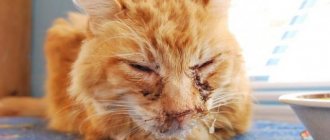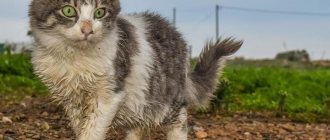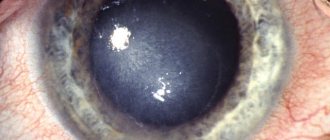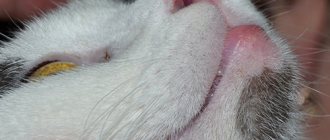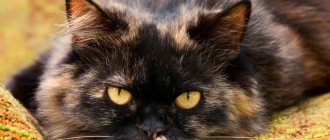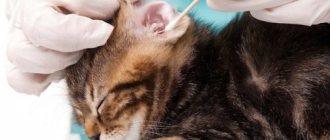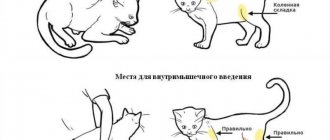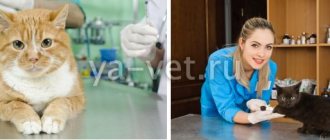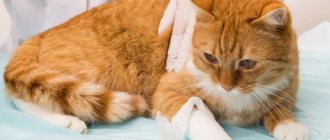Pancreatitis is an inflammation of the pancreas, which is responsible for the digestion process in the pet’s body. This disease is rarely diagnosed in cats, but it requires professional treatment. Read more about the causes of the pathology, its symptoms and treatment below.
Read in this article
- Symptoms of the disease
- Causes of pancreatitis
- Forms and their features
- Diagnosis of the disease
- Treatment of pancreatitis: stages
- Water-salt balance
- Elimination of pain
- Antiemetic therapy
- Restoration of the body
- Diet
- Surgical intervention
What is pancreatitis in a cat?
The development of the disease is associated with disruption of the pancreas, an important organ located directly under the stomach. His responsibilities include performing two functions:
- intrasecretory
, maintaining normal glucose levels and regulating the metabolism of carbohydrates and fats;
- exocrine
, which helps digest food by breaking down its main components.
In a normal situation, enzymes produced by the pancreas enter the duodenum. This is where the digestion process begins. When a malfunction occurs, some enzymes remain inside the organ that produces them. Digestion of healthy tissue occurs and subsequent intoxication of the body, accompanied by the development of inflammation.
Prices for appointments in our clinics
| Name of veterinary services | Unit | Price, rub |
| ⭐ Initial appointment | 1 animal | 400 |
| ⭐ Repeated appointment | 1 animal | 250 |
| Initial appointment with a specialist | 1 animal | 1100 |
| Consultation without an animal | — | 550 |
| Consultation with a doctor based on test results | 1 PC. | 400 |
| Weighing animals | 1 animal | For free |
| Additional fixation for aggressive animal behavior | 1 animal | 700 |
Causes of pathology
The risk group includes oriental breeds: Thais, Balinese, Orientals, Siamese. Also, the likelihood of developing the disease increases after reaching 8 years of age and during pregnancy.
The main causes of pancreatitis in cats include:
- Oncology, accompanied by an increase in calcium concentration in the blood plasma.
- Abdominal trauma, including failed sterilization or other abdominal surgery.
- Incorrect feeding. For mustachioed pets, a sudden transition to a new type of food, any food from the human table and fatty meats is dangerous. In addition to quality, it is important to consider the quantity of food. The disease is often diagnosed in animals that are overweight or underweight.
- Poisoning by poisons, chemicals, medications, spoiled food, household chemicals and other dangerous substances.
- Incorrect organ structure or congenital developmental pathologies.
- Infections (calcivirosis) and helminthiasis (infection with liver worms).
- Long-term antibiotic therapy or long-term treatment with sulfonamides, diuretics and hormones.
- Diseases of the gastrointestinal tract (cholecystitis, gastritis, cirrhosis).
- Stress. Prolonged exposure to a stress factor is detrimental not only to the psyche, but also to internal organs.
- Hormonal disorders, including thyroid pathologies, hypercortisolism syndrome and diabetes mellitus.
If there is no obvious cause, the disease is called idiopathic. In this case, eliminating the provoking factor turns out to be impossible.
Treatment of chronic and acute pancreatitis in cats directly depends on the cause of its occurrence. Only a veterinarian can make an accurate diagnosis, so do not try to find the source of the problem yourself. The longer a pet is left without help, the less likely it is to be saved.
Prevention
- Follow the vaccination schedule, regularly deworm and do not neglect preventive examinations.
- Strictly adhere to the diet, monitor the quality of food and ready-made commercial feed, and stop attempts at home to “treat” your pet with food from the table.
- Monitor your pet's weight and prevent obesity.
- Strictly adhere to the recommendations of veterinary specialists during treatment of chronic pancreatitis in the acute phase and during remission. Do not replace medications or change dosages of medications.
- Get rid of all poisonous houseplants.
- Place household chemicals out of the reach of cats.
Strict adherence to these simple rules will help your pet stay healthy longer.
Videos of veterinarians
Symptoms by form
Symptoms and signs of pancreatitis in cats are less severe than in dogs. The asymptomatic course at the initial stage prevents the timely detection of the disease. Because of this, representatives of the cat family often experience chronicity of the process.
Acute
Acute pancreatitis is very rare in cats. It is characterized by the sudden appearance of pronounced symptoms and rapid deterioration of the patient's condition. This form of pathology often occurs secondary - as a result of complications of another disease.
Due to a violation of the exocrine function, the pet begins to experience excruciating pain during and after feeding. The pain reaction is accompanied by arching of the back and the appearance of wheezing. Having traced the relationship, the animal refuses to eat, but this does not help it. Soon gastrointestinal disorders are added to the pain.
The cat has diarrhea. He is bothered by repeated and painful vomiting, which occurs even on an empty stomach. Due to excessive fluid loss, dehydration develops. This affects the functioning of the heart and lungs - the pet becomes lethargic, sleeps a lot and breathes quickly. If the outflow of bile is disrupted, yellowing of the mucous membranes and a rise in temperature are observed.
Chronic
Chronic pancreatitis in cats is more dangerous than acute pancreatitis. It can develop unnoticed for years, which reduces the chances of saving the animal. Despite the absence of obvious symptoms, the resulting disorders slowly destroy the body from the inside.
The symptoms of this form of pancreatitis in cats are similar to colds, helminthiasis and common indigestion. The sick person loses activity and eats little. He may suffer from occasional vomiting or diarrhea. Sometimes the color of the feces changes to yellow. Pieces of undigested food appear in them. Gradually he loses weight, and his coat loses its former shine.
The symptoms characteristic of this form do not look scary, but are also a deviation from the norm. It is important here not to wait for sudden self-healing. A change in the shape of the stool is the first alarm bell. If you notice periodic improvements alternating with setbacks, make an appointment with your veterinarian.
Risk factors
Often, veterinarians cannot determine the true cause of the disease, considering it idiopathic. In most cases, pancreatitis is the result of an unsuccessful operation or injury to the peritoneal area.
Cats that have had toxoplasmosis, infectious peritonitis or immunodeficiency virus are also at risk.
Some medications that cause poisoning in pets can cause the development of dangerous pathologies. For example, the prescription of aspirin or organophosphate poisoning.
How to Diagnose Pancreas Problems
In addition to collecting anamnesis and examination, it is necessary to conduct urine and blood tests. The second analysis is more informative: in addition to deviations in the main indicators, it shows the amount of pancreatic lipase. This enzyme is the main indicator of the disease, but due to the complexity of the procedure, this study is carried out by a small part of Russian veterinary clinics. Most are based on biochemistry indicators and a general blood test.
The pancreatic lipase immunoreactivity test does not always give an accurate result. Sometimes an increase in the indicator is associated with the presence of a foreign body in the intestine. To confirm the obtained result, several clarifying studies are carried out:
- X-ray, revealing the presence of a stuck object or tumors;
- Ultrasound of the abdominal cavity, showing the degree of damage to internal organs, changes in the size and color of the pancreas;
- biopsy is a study of a small fragment of biomaterial, considered the most accurate diagnostic method.
Due to the negligence of their owners, some pets can only be diagnosed posthumously. With acute pancreatitis in cats, there is very little time for rescue, so do not delay a visit to the clinic when you notice the first alarming signs.
Caring for a sick animal
The rules for caring for a cat during the recovery period are quite simple:
- The animal is provided with complete rest and protected from stress factors.
- For nutrition, we strongly recommend using veterinary holistic specialists. If “natural” is used, the diet should be prepared by an experienced veterinary nutritionist.
- Your pet should always have clean and fresh drinking water in unlimited quantities.
- During the treatment period, the cat is kept in a room with a stable temperature and is not allowed to have contact with the outside environment. The reason is a severe deterioration of immunity; any infection at this time can result in the death of the animal.
How to treat pancreatitis in cats
Treatments for pancreatitis in cats depend on the symptoms and cause. If the form is mild, the pet is treated at home, and if there is a threat to life, it is strictly in a hospital.
Medication
Unlike the liver, the pancreas is not able to repair its cells. There is no specific therapy for pathologies of this organ, so treatment is based on eliminating possible causes and relieving symptoms. The functionality of the gland will never be the same, but with timely help it will be enough to maintain the animal’s life.
First of all, the mustachioed patient is restored to the water-salt balance, disturbed due to dehydration. He is given subcutaneous or intravenous drips with infusion solutions (Regidron, Acesol, saline solution with glucose, Dextran-70, Ringer's solution). If the glucose value is elevated, it is lowered with the help of Reamberin or Caninsulin. To boost immunity, vitamin C, iron and antioxidants (Emicidin, Mexidol) are added to the solutions.
Debilitating attacks of vomiting that prevent independent consumption of food are suppressed with Zofran, Cerucal or Serenya. All medications are agreed with the doctor. Self-administration of medications is fraught with complications. The same Cerucal, which stimulates gastrointestinal motility, can cause internal bleeding if a foreign body is in the intestine. Until vomiting is eliminated, animals are fed through a special tube, stimulating appetite with Mirtazapine.
In especially severe cases, blood or plasma transfusions are used. This procedure is available in a limited number of veterinary clinics, so a sick cat may be sent to hospital treatment far from home.
To relieve acute pain, it is recommended to take opioid analgesics (Fentanyl, Tramadol, Butorphanol). Unlike classic painkillers, these medications do not increase stomach acidity. The problem is that most veterinary clinics do not have opioids, so the pain is relieved with Baralgin, Papaverine and Spazgan. These drugs are less effective, and if there is an ulcer, they are even dangerous.
To protect ulcerated mucous membranes, antacids and gastroprotectors are used: Famotidine, Phosphalugel, Omeprazole, Ranitidine. Intravenous administration of albumin is also recommended for patients with stomach or intestinal ulcers. This is necessary to prevent pulmonary edema.
Digestive function is normalized by taking pancreatic enzymes (Pancreatin, Creon). If a secondary bacterial infection is detected, antibiotic therapy is prescribed using broad-spectrum drugs: Sinulox, Cefazolin. To suppress the increased production of pancreatic lipase, its inhibitors (Gordox, Kontrikal) are prescribed.
Surgically
The operation is performed when there is blockage of the bile duct, the presence of abscesses, cysts or tissue necrosis, as well as the lack of effect of drug treatment or the impossibility of making a diagnosis in any other way. Surgical intervention in the abdominal cavity is performed under general anesthesia.
During the operation, the peritoneum is incised along the linea alba and the resulting incision is secured with special dilators. To identify the cause of the pathology, the surgeon carefully examines and palpates the internal organs. He removes the accumulated liquid with a special syringe. Dead tissue and cysts are carefully removed with a scalpel. To relieve pain, a novocaine blockade is placed. If generalized peritonitis is detected, the wound is not sutured, since weekly rinsing with saline solution is required to eliminate it. This procedure is carried out under sedation, tightening the incision until the next time.
Regardless of the treatment method, all animals are given a gentle diet. It relieves the load on the affected organ, helping to normalize its functioning. For patients with a chronic diagnosis, therapeutic nutrition continues throughout life.
Diet
In the absence of severe exhaustion, the mustachioed patient is prescribed a starvation diet. This eliminates the need for digestion and gives time to restore the functionality of the diseased organ. The duration of the fasting diet is selected individually; in kittens it is always less than in adult pets.
At the end of the starvation diet, the animal is fed according to the following rules:
- The number of feedings increases in favor of reducing portions. Fractional meals are the basis of any gentle nutrition.
- All food is served in liquid or pureed form. The absence of coarse fibers reduces the load on the gastrointestinal tract.
- The temperature of the food should not be lower or higher than room temperature. Digesting cold food requires more effort and time, and food that is too hot can burn your mucous membranes. This is especially dangerous if you have an ulcer.
When feeding natural food, use lean meats (rabbit, chicken, turkey) and watery cereals (rice, oatmeal, buckwheat). Animal proteins can also be obtained from steamed protein omelettes and fermented milk products with low fat content, but rich in calcium. For vegetables, it is better to choose pureed carrots or zucchini.
During treatment, strong meat broths and fruits and vegetables that have not undergone heat treatment are prohibited. Fatty fish and meats, as well as legumes and milk are no less dangerous, but they are not recommended for consumption even by healthy animals.
In pet stores and veterinary clinics you can purchase medicinal food for cats with pancreatitis marked i/d. Most well-known brands have this line, so it is preferable to choose the one that you already feed your pet.
At first, instead of granules, it is better to give pouches or canned food with soft pieces - they are easier to digest. Each package contains convenient instructions to help you determine the required amount. If your pet is exhausted or obese, it is better to discuss the daily serving size with your veterinarian.
Diet food
For pancreatitis and after treatment, food should be dietary for a long time.
What can you feed a cat with pancreatitis:
- low-fat broth;
- boiled chicken, turkey or veal;
- lean fish;
- boiled porridge - rolled oats, crushed rice and chopped buckwheat;
- A few boiled vegetables are allowed - carrots, zucchini, potatoes.
It is important to follow the feeding rules:
- The daily portion should be divided into 5-6 times.
- Cold or very warm foods should be avoided.
- Any uneaten portion should be removed immediately to prevent spoilage.
- Meat and fish should only be given boiled, in small pieces or minced.
- The bowl should always contain water at room temperature. It needs to be changed several times a day.
- Raw vegetables and fruits should be excluded from the menu. Fatty, salty or spicy foods are not allowed. Food cannot be given “from the table” to cats; food for them must be prepared separately. For some time after recovery, eggs in any form, dairy and fermented milk products are undesirable.
Complications and consequences
High mortality in the acute form is associated with early complications arising from the inflammatory process. It leads to thrombosis, internal bleeding, liver and respiratory failure.
With a prolonged course of the disease, the likelihood of developing oncology and the appearance of fistulas increases. The body's defenses gradually decline, so it becomes vulnerable to pathogenic microorganisms. In the event of a secondary infection, not only the pancreas suffers, but also the nearby intestines and other neighboring tissues. This leads to purulent abscesses, fraught with the appearance of sepsis. With this outcome, the animal may die from blood poisoning.
Another dangerous complication is pancreatic necrosis. This pathology is accompanied by the death of tissue of the affected organ and loss of its functionality. Enzymes and breakdown products entering the bloodstream aggravate intoxication. Not only the immediate organs are in danger, but also the heart and brain. In 90% of cases, pancreatic necrosis is incurable.
With late treatment, the acute form develops into a chronic form. Like pancreatic necrosis, it is incurable. Treatment is based on symptomatic therapy, lifelong diet and regular prevention.
Symptoms
The disease is characterized by a latent course, symptoms are usually not expressed. The destructive effect in the body occurs rather slowly and in the first stages is manifested only by apathy and weakness of the animal.
Particular attention should be paid if the cat has become drowsy and less active.
In the future, the following symptoms may appear:
- profuse and regular vomiting;
- loose stools with a sour odor;
- accelerated heartbeat;
- shallow breathing, often rapid;
- increased body temperature;
- yellowness of the mucous membranes and skin;
- pain syndrome as a result of palpation of the abdomen.
Symptoms do not appear immediately. As a rule, this happens gradually and depends on the stage of the disease.
Good to know
- Antiemetic pharmacological agents - Antiemetics - Dopamine receptor antagonists in dogs and cats
- Anal atresia in cats (Atresia ani)
- Brachycephalic syndrome in cats
- Gastroprotectors of the group of prostaglandin analogues and the mucosal protector sucralfate in dogs and cats
- Antiemetics – Phenothiazines – Antiemetics for the treatment of dogs and cats
- IBD in cats. Inflammatory bowel disease in cats
- Lack of molecular epidemiological data supporting domestic animal transmission of zoonotic Giardia duodenalis and Cryptosporidium spp. from domestic dogs and cats
